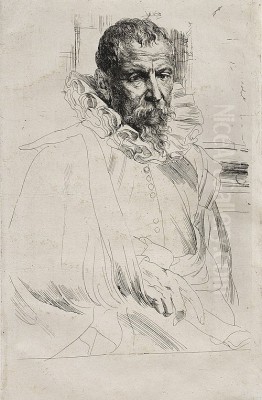
Pieter Brueghel the Younger stands as a fascinating figure in the rich tapestry of Flemish art history. Born into perhaps the most famous artistic dynasty of the Low Countries, he navigated a career defined both by the towering legacy of his father and his own considerable success as a painter and workshop master in Antwerp. Often overshadowed by his genius father, Pieter Bruegel the Elder, and sometimes confused with his talented brother, Jan Brueghel the Elder, Pieter the Younger carved out a distinct and highly productive niche for himself, ensuring the continued popularity of the Bruegelian style well into the 17th century.
His life, spanning from approximately 1564 or 1565 to 1637 or 1638, coincided with a period of significant political, religious, and artistic change in the Southern Netherlands. While primarily known for his numerous copies and variations of his father's compositions, a closer look reveals an artist who adapted to market demands, managed a thriving enterprise, and contributed his own interpretations to the enduring themes of peasant life, landscape, and religious narrative. Understanding Pieter Brueghel the Younger requires appreciating his role as an inheritor, an interpreter, and a highly successful entrepreneur in the bustling art center of Antwerp.
Early Life and Artistic Formation
Pieter Brueghel the Younger was born in Brussels around 1564 or 1565. He was the eldest son of the renowned painter Pieter Bruegel the Elder (c. 1525-1569), whose innovative depictions of peasant life and expansive landscapes had already secured his place as a pivotal figure in Northern Renaissance art. Tragedy struck the family early; Pieter the Elder died in 1569, when young Pieter was merely four or five years old. His mother, Mayken Coecke van Aelst (daughter of the painter Pieter Coecke van Aelst), passed away not long after, in 1578.
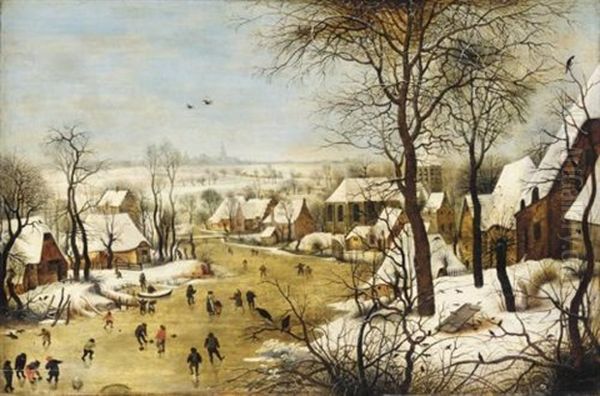
Consequently, neither Pieter the Younger nor his younger brother Jan Brueghel (born 1568, later known as 'Velvet' Brueghel) received direct artistic training from their famous father. Their artistic upbringing fell to their maternal grandmother, Mayken Verhulst. Verhulst was herself an accomplished artist, noted particularly for her miniatures and watercolors, and she likely provided the brothers with their foundational artistic education. This connection through the female line highlights the often-underestimated role of women in transmitting artistic knowledge within family workshops during this period.
The family moved to Antwerp sometime after 1578. Antwerp was the economic and artistic hub of the Southern Netherlands, offering far greater opportunities for aspiring artists than Brussels at the time. It is documented that Pieter the Younger studied under the landscape painter Gillis van Coninxloo (1544-1607). Van Coninxloo was a significant master known for his detailed forest landscapes, and his influence might be discerned in some of Pieter the Younger's handling of natural settings, although the dominant influence remained his father's work. In 1584 or 1585, Pieter Brueghel the Younger was registered as an independent master in the Antwerp Guild of Saint Luke, the official body governing painters and other artisans, marking the formal beginning of his professional career.
The Brueghel Artistic Dynasty
The Brueghel name carried immense weight in the art world of the late 16th and 17th centuries. Pieter the Younger and his brother Jan were central figures in continuing this legacy, though they pursued distinct artistic paths. While Pieter the Younger focused heavily on replicating and adapting their father's popular compositions, Jan Brueghel the Elder developed a highly refined style specializing in detailed flower paintings, allegorical scenes, mythological subjects, and landscapes, often collaborating with other leading Antwerp artists like Peter Paul Rubens (1577-1640).
The dynasty did not end with them. Jan Brueghel the Elder's son, Jan Brueghel the Younger (1601-1678), continued the family workshop, often painting in a style similar to his father's. Furthermore, Pieter the Younger's daughter, Anna, married David Teniers the Younger (1610-1690), another hugely successful Flemish painter known for his genre scenes. Teniers, in turn, drew inspiration from the Brueghel tradition, particularly the peasant themes popularized by Pieter the Elder and disseminated by Pieter the Younger.
This intricate web of familial and artistic connections underscores the importance of lineage and workshop traditions in Flemish art. Pieter the Younger operated within this context, leveraging his family name while also building his own reputation. His decision to focus on his father's compositions was likely a shrewd commercial strategy, capitalizing on the enduring demand for Pieter Bruegel the Elder's unique vision.
The Antwerp Workshop: A Prolific Enterprise
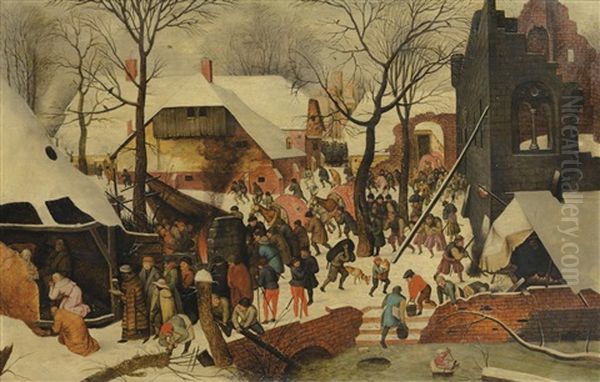
Upon becoming a master, Pieter Brueghel the Younger established his own workshop in Antwerp. This workshop became exceptionally productive, churning out a vast number of paintings over several decades. His success was built on the continued popularity of his father's imagery – scenes of peasant festivals, proverbs illustrated through everyday life, religious narratives set in contemporary Flemish landscapes, and allegorical representations.
The scale of production suggests a well-organized operation employing numerous assistants and apprentices. One notable apprentice was Frans Snyders (1579-1657), who would later become one of the foremost Flemish painters of animals and still lifes, often collaborating with Rubens and Anthony van Dyck (1599-1641). The presence of talented assistants was crucial for maintaining the high output of the workshop.
To facilitate the replication process, the workshop likely employed techniques such as pouncing. This involved creating detailed drawings or cartoons of the original compositions. Small holes were pricked along the main lines of the drawing, which was then placed over a new panel or canvas. Charcoal dust was 'pounced' through the holes, transferring the basic outline onto the new surface. This allowed for rapid and relatively accurate reproduction of compositions, which assistants could then paint according to the established model. This method explains the existence of numerous versions of the same composition, often with minor variations in detail or color.
The market for these works was broad. While high-ranking patrons might seek unique commissions from masters like Rubens, there was a substantial middle-class clientele, both locally and internationally, eager for recognizable and engaging Bruegelian scenes. Pieter the Younger's workshop catered effectively to this demand, producing paintings at various price points. His commercial acumen in managing this large-scale production was a key factor in his sustained success.
Artistic Style: Echoes of the Father
The most defining characteristic of Pieter Brueghel the Younger's art is its deep connection to the work of Pieter Bruegel the Elder. He revisited his father's most famous compositions repeatedly, demonstrating a profound understanding of their structure and narrative content. Subjects like the Netherlandish Proverbs, Children's Games, The Sermon of St. John the Baptist, various peasant weddings and dances, and seasonal landscapes formed the core of his output.
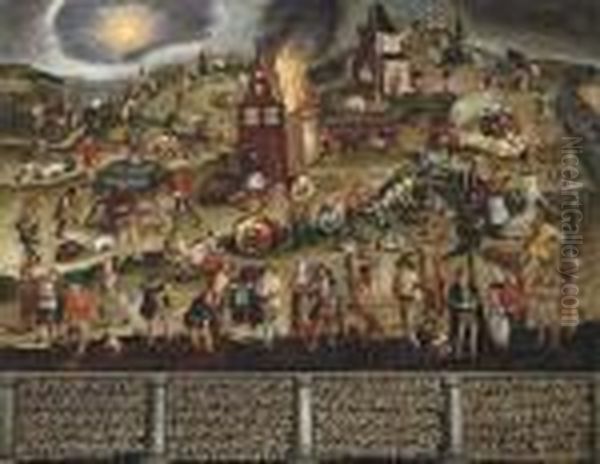
In replicating these works, Pieter the Younger often adopted his father's high viewpoints, bustling multi-figure compositions, and keen observation of everyday life. He also inherited a vibrant color palette, though his application of color sometimes differed from his father's more subtle and harmonious approach. His paintings often feature bright, strong, and somewhat more contrasting colors, lending them a distinct energy and visual impact that appealed to contemporary tastes.
He captured the dynamism and earthiness of his father's peasant scenes – the boisterous energy of a kermesse (village fair), the clumsy grace of dancers, the raw interactions of villagers. These depictions, while sometimes lacking the profound humanism and psychological depth of his father's originals, were nonetheless lively, engaging, and highly decorative. They satisfied a market fascinated by rural life, seen perhaps with a degree of nostalgic or humorous detachment by urban patrons.
Artistic Style: Developing an Identity
While copying was central to his practice, it would be inaccurate to dismiss Pieter Brueghel the Younger as a mere imitator. Over his long career, his style evolved, and he introduced his own nuances and interpretations. His copies were not always slavish reproductions; he often adapted compositions, altered details, changed color schemes, or updated costumes to reflect contemporary fashion.
Compared to his father, his figures can sometimes appear slightly stiffer or more caricatured, and his brushwork might be less refined. However, his paintings often possess a clarity and directness that is distinctly his own. His use of brighter, sometimes even harsher, colors became a hallmark, distinguishing his work from the more muted tones often found in Pieter the Elder's originals. This bolder palette might reflect the prevailing tastes of the early Baroque period.
Furthermore, Pieter the Younger did produce original compositions, although identifying them definitively can be challenging due to the workshop's nature. Works like The Peasant Lawyer (also known as The Village Lawyer or The Tax Collector's Office), depicting villagers bringing goods to an officious lawyer figure, became immensely popular and exist in numerous versions. While potentially based on a lost prototype by his father or another artist, its widespread production under Pieter the Younger suggests it was a theme he made his own. Other original contributions likely exist among his numerous depictions of village fairs and specific religious scenes.
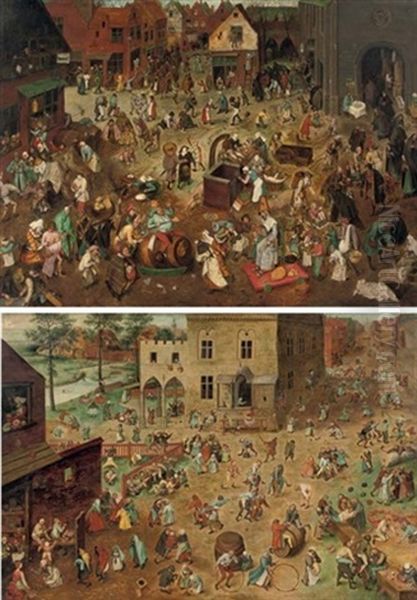
His later works, particularly from the 1620s onwards, sometimes show a looser brushstroke and a continued preference for vivid colors. He remained active until late in life, managing his workshop and continuing to paint popular themes. While he never achieved the revolutionary artistic status of his father or the refined elegance of his brother Jan, he successfully navigated the demands of the art market, creating a substantial and recognizable body of work.
The "Hell Brueghel" Nickname
Pieter Brueghel the Younger acquired the nickname "de Helse Brueghel" or "Hell Brueghel." This moniker arose primarily from his early fascination with subjects involving fire, devils, grotesque creatures, and scenes of the underworld or damnation, such as depictions of the Temptation of St. Anthony or Christ's Descent into Limbo. These themes were popular in the late 16th century, drawing on a tradition heavily influenced by Hieronymus Bosch (c. 1450-1516).
While Pieter the Younger painted several such dramatic and fiery scenes, often based on compositions by his father or drawing from the Boschian tradition, the nickname is somewhat misleading if applied to his entire oeuvre. The vast majority of his work focuses on peasant life, landscapes, and more conventional religious subjects, rather than infernal visions. However, the nickname stuck, perhaps due to the memorable and striking nature of these particular works.
It's important to distinguish his interest in these themes from the fantastical elements sometimes present in his father's work, such as The Fall of the Rebel Angels or Dulle Griet. While Pieter the Elder used monstrous figures for complex allegorical or moralizing purposes, Pieter the Younger's "hellscapes" often seem more focused on the dramatic visual spectacle of flames and demonic figures, catering to a taste for the sensational.
Representative Works and Themes
Pieter Brueghel the Younger's workshop produced hundreds, if not thousands, of paintings. Among the most frequently recurring and representative themes and specific compositions are:
Winter Landscape with Skaters and Bird Trap: Arguably the most reproduced composition associated with him, based on a beloved original by Pieter the Elder. Dozens of versions by Pieter the Younger and his workshop exist. The scene depicts villagers skating and playing on a frozen river near a snow-covered village, with a prominent bird trap in the foreground. Its enduring appeal lies in its charming depiction of winter activities and its potential allegorical meanings concerning the precariousness of life.
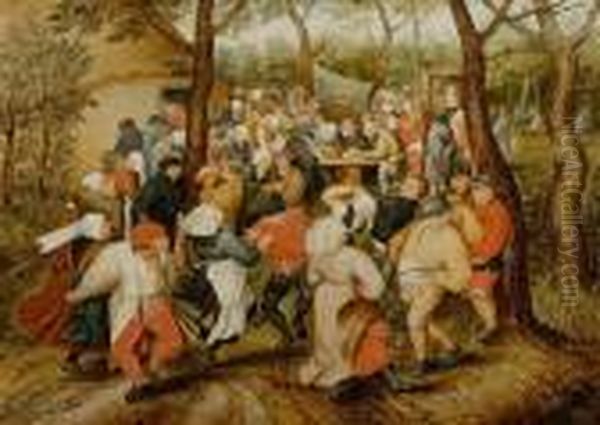
The Peasant Wedding Dance (or Village Fair / Kermesse): Numerous variations exist depicting outdoor peasant celebrations. These bustling scenes, filled with eating, drinking, dancing, and carousing figures, capture the lively atmosphere of village festivals. They are directly inspired by Pieter the Elder's famous depictions of peasant life, such as The Peasant Dance and The Peasant Wedding. Pieter the Younger's versions often emphasize the energetic, sometimes chaotic, nature of these gatherings.
The Peasant Lawyer (The Village Lawyer / The Tax Collector's Office): As mentioned, this appears to be one of Pieter the Younger's most successful original or adapted themes. It shows a lawyer's office crowded with peasants bringing payments in kind (eggs, fowl, etc.). The lawyer, often portrayed with spectacles and a self-important air, meticulously records the transactions. The scene offers a satirical glimpse into village administration and social hierarchy.
The Adoration of the Magi in the Snow: Another theme borrowed from his father, this composition sets the biblical event within a contemporary Flemish winter landscape. The exotic Magi and their retinue contrast with the snowy village and its inhabitants going about their daily lives. Pieter the Younger produced many versions, often highlighting the atmospheric effects of snow and the anecdotal details of the surrounding crowd.
The Bearing of the Cross: Based on Pieter the Elder's monumental composition, these paintings depict Christ carrying the cross towards Calvary, set within a vast, panoramic landscape crowded with figures. Pieter the Younger's versions simplify the composition but retain the sense of a major event unfolding amidst the indifference or curiosity of a large crowd, embedding the sacred narrative within a familiar Flemish setting.
Netherlandish Proverbs and Children's Games: He also frequently reproduced his father's complex allegorical paintings illustrating numerous proverbs and children's games, making these intricate compositions accessible to a wider audience.
These examples illustrate the core of Pieter the Younger's production: taking successful Bruegelian themes and compositions and reproducing them with slight variations for a receptive market, ensuring the Bruegel 'brand' remained prominent.
Contemporaries and Influence
Pieter Brueghel the Younger worked during a golden age of painting in Antwerp. The city was home to giants like Peter Paul Rubens, Anthony van Dyck, and Jacob Jordaens (1593-1678), who were revolutionizing Baroque painting with their dynamic compositions, dramatic lighting, and rich textures. While Pieter the Younger's style remained more rooted in the 16th-century tradition of his father, he was undoubtedly aware of these developments.
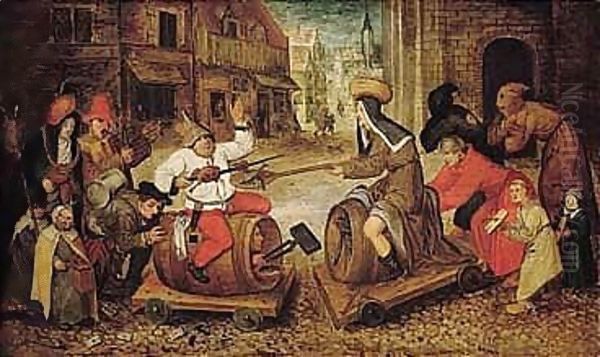
His workshop co-existed alongside these larger, more internationally renowned studios. While Rubens catered to royalty, the Church, and the highest echelons of society with large-scale historical and mythological paintings, Pieter the Younger served a different segment of the market. His relationship with contemporaries like Frans Snyders (his former pupil) and landscape specialists such as Joos de Momper (1564-1635), who sometimes collaborated with Jan Brueghel the Elder, places him firmly within the network of Antwerp artists. He also worked alongside painters specializing in similar genre themes, such as Sebastiaen Vrancx (1573-1647), known for his battle scenes and depictions of robbers.
Pieter the Younger's primary influence lay not in stylistic innovation but in the dissemination and popularization of his father's work. By creating countless copies and variants, he ensured that Pieter Bruegel the Elder's unique vision of peasant life and landscape remained deeply ingrained in Flemish visual culture. His success demonstrated the commercial viability of genre painting and likely encouraged other artists, including his son-in-law David Teniers the Younger and figures like Adriaen Brouwer (1605/6-1638) and Adriaen van Ostade (1610-1685) (though primarily active in the Dutch Republic), to explore themes of everyday life.
His production methods also highlight the business side of art in the 17th century. His workshop model, focused on efficient reproduction of popular models, was a highly effective commercial strategy, different from the more commission-based work of artists like Rubens or Van Dyck, but equally successful in its own right.
Later Life and Legacy
Pieter Brueghel the Younger continued to run his successful workshop in Antwerp throughout the early decades of the 17th century. He married Elisabeth Goddelet in 1588, and they had seven children, though historical records suggest several may have died young, a common tragedy in that era. His son, Pieter Brueghel III (born 1589), also became a painter, though he did not achieve the fame of his father or uncle.
Pieter the Younger died in Antwerp between September 1637 and October 1638. He left behind a vast body of work, scattered across museums and private collections worldwide. For a long time, his reputation suffered in comparison to his father's. Art historians often dismissed him as a mere copyist, lacking originality. Many of his works were even misattributed to Pieter the Elder during the 18th and 19th centuries when the distinctions between them were less clearly understood.
However, the 20th century saw a reassessment of his contribution. Scholars began to study his workshop practices, differentiate his style more clearly from his father's, and appreciate his role in popularizing Bruegelian imagery. Exhibitions dedicated to his work have highlighted the quality and consistency of his output, as well as his occasional departures into original compositions.
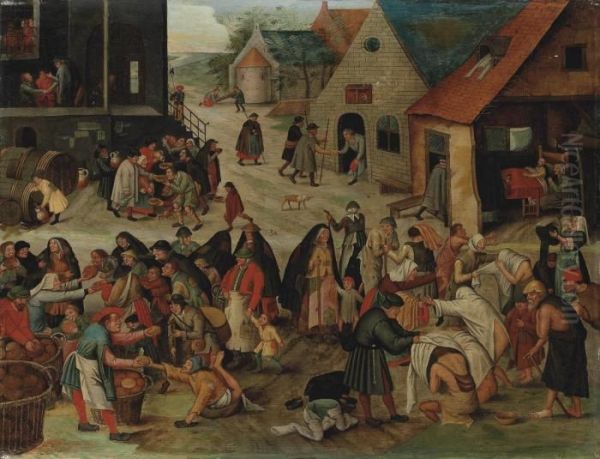
His legacy is twofold. Firstly, he played a crucial role in preserving and transmitting the artistic heritage of Pieter Bruegel the Elder at a time when the original works were becoming scarce and highly prized. Without his numerous copies, our understanding and visual record of some of his father's compositions might be diminished. Secondly, he demonstrated the power of a well-run workshop and the existence of a strong market for genre painting, contributing significantly to the artistic economy of Antwerp and the enduring popularity of scenes depicting Flemish life.
Conclusion: An Enduring Interpreter
Pieter Brueghel the Younger occupies a unique and significant place in art history. As the inheritor of a celebrated name and artistic tradition, he faced the challenge of living up to his father's genius. His solution was pragmatic and highly successful: he became the primary interpreter and disseminator of the Bruegelian style. Through his prolific workshop, he satisfied an enormous public appetite for the vibrant peasant scenes, detailed landscapes, and engaging narratives pioneered by his father.
While often labeled a copyist, and sometimes overshadowed by the towering figures of Flemish Baroque like Rubens, his contribution was vital. He was not just replicating; he was translating and adapting his father's vision for a new generation and a broader audience. His work kept the Bruegelian spirit alive and influential well into the 17th century. Known for his bright colors, energetic scenes, and the sheer volume of his output, Pieter Brueghel the Younger, the "Hell Brueghel" who painted far more than just hellscapes, remains a key figure for understanding the continuity of artistic traditions and the dynamics of the art market in the Southern Netherlands.